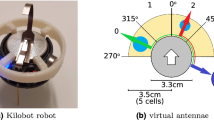Abstract
This study investigates the formation of nested structures in swarms of intelligent agents that can freely move in three dimensions. The underlying segregation mechanism is inspired by the Brazil nut effect, which occurs when granular mixtures are subjected to vibrations [6,1]. Similar effects were reported for brood items sorted by ants [3]. This sorting behaviour was validated with swarms of mobile robots [7,5]. Different from these studies we are concerned with sorting the agents themselves. In [4], we proposed a controller based on the Brazil nut effect that was capable of segregating groups of simulated e-puck robots reliably in two dimensions. In the present study, we investigate a 3D particle system implemented in NetLogo1. The agentsmimic the behaviour of particles of distinct sizes. The motion of each agent is determined by three types of vectors [4]: (i) a repulsion vector for every agent that intrudes the particle’s virtual body, (ii) a random vector simulating vibrations, (iii) and a “gravitational” vector that points to a “centre” location. The agents do not communicate. However, the repulsion behaviour requires them to sense each others’ relative positions within their particle range. The segregation quality is measured as the percentage of pairs of particles from different groups that are segregated correctly (based on distance to centre) [4]. A value of 100% corresponds to perfect structures with all large agents surrounding the small agents, 50% corresponds to purely random structures, whereas 0% corresponds to perfect but inverted structures.
Access this chapter
Tax calculation will be finalised at checkout
Purchases are for personal use only
Similar content being viewed by others
References
Barker, G., Grimson, M.: The physics of muesli. New Scientist 126(1718), 37–40 (1990)
Foster, S., Groß, R.: Online supplementary material (2011), http://naturalrobotics.group.shef.ac.uk/supp/2011-003
Franks, N.R., Sendova-Franks, A.B.: Brood sorting by ants: Distributing the workload over the work-surface. Behav. Ecol. Sociobiol. 30(2), 109–123 (1992)
Groß, R., Magnenat, S., Mondada, F.: Segregation in swarms of mobile robots based on the Brazil nut effect. In: Proc. of the 2009 IEEE/RSJ Int. Conf. on Intelligent Robots and Systems, IROS 2009, pp. 4349–4356. IEEE Computer Society Press, Los Alamitos (2009)
Melhuish, C., Sendova-Franks, A.B., Scholes, S., Horsfield, I., Welsby, F.: Ant-inspired sorting by robots: The importance of initial clustering. J. Roy. Soc. Interface 3(7), 235–242 (2006)
Rosato, A., Strandburg, K.J., Prinz, F., Swendsen, R.H.: Why the Brazil nuts are on top: Size segregation of particulate matter by shaking. Phys. Rev. Lett. 58(10), 1038–1040 (1987)
Wilson, M., Melhuish, C., Sendova-Franks, A.B., Scholes, S.: Algorithms for building annular structures with minimalist robots inspired by brood sorting in ant colonies. Auton. Robot. 17(2-3), 115–136 (2004)
Author information
Authors and Affiliations
Editor information
Editors and Affiliations
Rights and permissions
Copyright information
© 2011 Springer-Verlag Berlin Heidelberg
About this paper
Cite this paper
Foster, S., Groß, R. (2011). Forming Nested 3D Structures Based on the Brazil Nut Effect. In: Groß, R., Alboul, L., Melhuish, C., Witkowski, M., Prescott, T.J., Penders, J. (eds) Towards Autonomous Robotic Systems. TAROS 2011. Lecture Notes in Computer Science(), vol 6856. Springer, Berlin, Heidelberg. https://doi.org/10.1007/978-3-642-23232-9_44
Download citation
DOI: https://doi.org/10.1007/978-3-642-23232-9_44
Publisher Name: Springer, Berlin, Heidelberg
Print ISBN: 978-3-642-23231-2
Online ISBN: 978-3-642-23232-9
eBook Packages: Computer ScienceComputer Science (R0)




